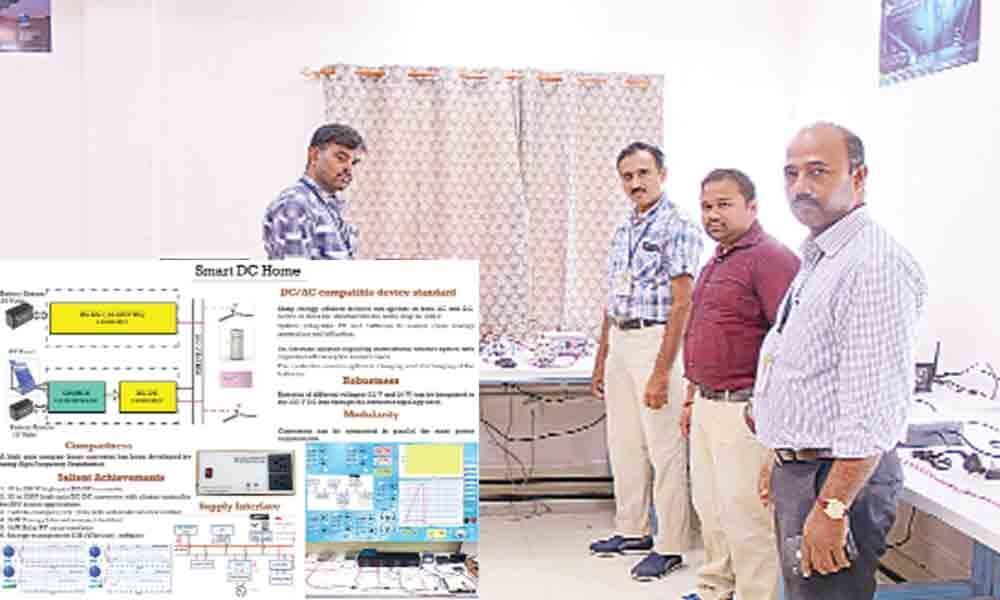Live
- Jogulamba Gadwal Police Solve Kidnapping Case in Record 8 Hours, Victim Reunited with Family
- Digital Arrests Do Not Exist… Be Cautious of Cyber Criminals - Cyber DSP Giri Kumar Kalkota
- Everyone must follow road safety rules
- Pilligundla Colony Residents Seek Justice Over Anjaneya Swamy Temple Land Dispute
- BJP Leader S Ramachandra Reddy Slams Alliance 1 Company for Exploiting Tobacco Farmers
- Timely Intervention by MLA & MLC Ensures Water Release from Tungabhadra Dam for Alampur Farmers
- NASA Astronaut Captures Stunning Aurora from Space, Sparks Debate on Authenticity
- India Squad for Champions Trophy 2025 and England ODIs: Live Updates on Mohammed Shami's Return
- District Collector Directs Swift Completion of Pending Development Works in Aija Municipality
- Triptii Dimri's Aashiqui 3 Exit Due to Bold Image in Animal, Kangana Ranaut Reacts to Censor Board Cuts in Emergency
Just In
Customised converter designed by KSRMCE


An innovative converter has been proposed which operates over a wide range duty. This converter has four power stages, which can able to boost output voltage to up to 230V DC and beyond as per requirement.
An innovative converter has been proposed which operates over a wide range duty. This converter has four power stages, which can able to boost output voltage to up to 230V DC and beyond as per requirement. Moreover, the converter has a compact design and operated with a maximum efficiency of 93.4 per cent.
Brief descriptions of the features are given below:
1. Wide input range: Input ranging from 11-48 V can be given to the converter.
2. Wide output range: Output ranging from 50-315 V can be obtained.
3. Inherent soft switching scheme: Zero voltage switching (ZVS) is used so that switching losses are reduced.
4. Dual control loop: A robust dual control loop strategy is used that controls the input current and tightly regulates output voltage.
5. Single sensor: This converter uses a single current sensor instead of two sensors (voltage and current) required for dual loop control.
6. Modularity: The unique feature of this converter is that it is modular and can be easily paralleled with another similar converter to increase the power rating.
7. Efficiency reported as high as 93.7% at light loads and with an average efficiency of 86% over a wide range of loads
Further, an innovative frequency responsive charger has been designed for Indian scenario and its details are as follows:
Current systems that regulate electric power lie almost exclusively on the supply side, requiring utilities to constantly adjust the power output of their generating units to match the consumer demand. By contrast, the developed system operates from the demand side, relying on a highly responsive frequency-sensing charge controller. The controller continuously monitors electric grid frequency and compares it to a predefined tolerance band, then applies to a digital signal processing controller. A charge controller and switch connected to a battery charger receive respective identified control actions for managing the charger. The controller responds automatically to drop in grid frequency as low as 0.1 Hz and charge the electrical vehicle. In this way, it turns the charging load of electric vehicles in to a frequency responsive load which helps regulate system frequency from the demand side and reduces the need for under frequency shedding of other consumers.
Innovative features:
1. Small, in expensive to manufacture and easy to install
2. Can be installed on a vehicle or its battery charger
3. Requires no maintenance
4. Operates automatically; does not need signals from the utility dispatch centre
5. Permits better integration of intermittent renewable energy sources in to the power grid by quickly compensating for their variability
6. Safe: not vulnerable to cyber-attack
7. Increases the reliability and security of the power supply and reduces the risk of power outages
Renewable energy resources play a vital role for clean energy initiative in India. The energy obtained from solar PV cell is in the form of direct current with few tens of volts, which cannot be utilised directly for home appliances. However, this voltage can be increased by connecting the PV modules in different series/parallel combinations. Assuming the power consumption of a general middle class is of around 200W (2 tube lights, 1 refrigerator, 1 fan and 1 TV). The standard PV panel rating available in the market is of 100Watts with 17.8 open circuit voltage. Even if two PV panels are connected in series, the maximum open circuit voltage obtained is of 35.6 Volts.
In order to operate the PV at maximum power, the open circuit voltage may further reduce. Hence, it became a mandate to general home users to boost the voltage from variable input to constant output. Hence, there is a need to step up the voltage from few tens of variable input voltage to 230 V DC (first time in India). For the first time, authors, puts forward a standardization of 230 V DC for Indian scenario. Because, most of the energy efficient devices are equipped to work with both on AC and DC supply.
The standard Indian single-phase AC voltage is 230 V, hence authors took the advantage for reliable operation, and it is proposed to standard as 230 V for DC as well. Some other application areas of these converters include sensitive medical equipment, electric vehicles, computer supplies etc.
General dc-dc boost converter steps up the input dc voltage by some factor so that a higher output voltage is obtained. Common dc sources like batteries, fuel cells generally have a low terminal voltage (12-24V). Boost converters should be able to step up the voltage in the range of 200-220V DC. This requires a high boost gain to the tune of 40-50 times. Conventional boost converter that uses an isolated/non-isolated topology is relatively simple to realize but limited duty cycle is its major drawback.

© 2024 Hyderabad Media House Limited/The Hans India. All rights reserved. Powered by hocalwire.com






